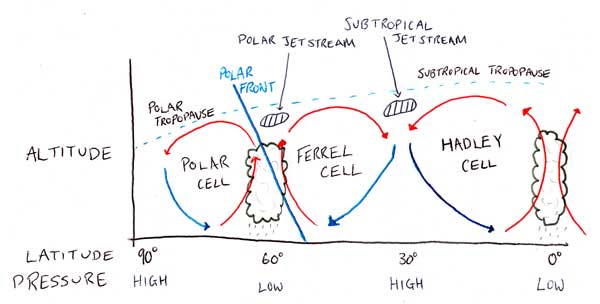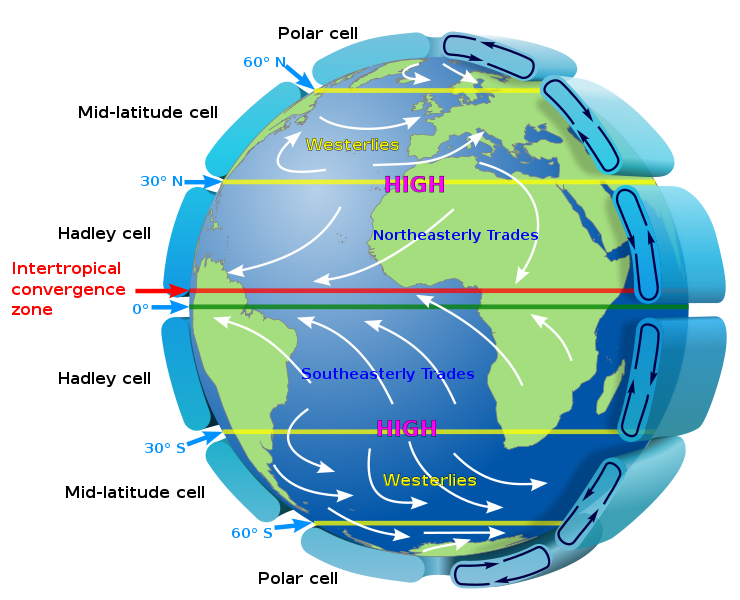The Earth and its atmosphere are both controlled primarily by the Sun and together, they make up an interconnected global system leading to atmospheric circulation. Different climates in different areas result from atmospheric movements (see the tricellular model below) within this global system. The reason behind these atmospheric movements is the difference in temperature between equatorial regions and polar regions, which is caused by the distance from the Sun and the amount of atmosphere travelled through.
In general, it is the energy that flows in the atmosphere that causes variations in our weather and climate.
The Tricellular Model
The tricellular model consists of three different air masses; these control atmospheric movements and the redistribution of heat energy. The three air masses, starting from the equator, are the Hadley cell, Ferrel cell, and the Polar cell.
The tricellular model also contains the ITCZ (Intertropical convergence zone), the meeting place of the trade winds from both the northern hemisphere and the southern hemisphere. The ITCZ is a low-pressure area where the trade winds, which have picked up latent heat as they crossed oceans, are now forced to rise by convection currents. These rising convection currents are then cooled adiabatically to form massive cumulonimbus clouds.

As seen in the diagram, the rising air at the ITCZ leads to a circular movement caused by the cooling of the air, called the Coriolis effect. This leads to the formation of the first air mass, called the Hadley cell, named after its discoverer.

The Jet Streams & Rossby Waves
Between the different atmospheric cells high up in the tropopause, at a height of about 5 miles, are the jet streams: the polar jet stream (40-60°N+S) and the subtropical jet stream (25-30°N+S). These jet streams move air at high speeds up to 130mph around the Earth horizontally and give rise to Rossby waves, which are types of inertial waves naturally occurring in rotating fluids. These jet streams were first discovered when Zeppelins were blown off course in WW1.
Rossby waves were discovered by Carl-Gustaf Rossby, a Swedish meteorologist, in the 1930s. They are waves or zigzags in the jet streams as they travel around the Earth. The number of waves varies throughout the year but usually, in the summer, it’s between four and six while in winter it’s about three.
Read more about Convection Currents
Frequently Asked Questions
What is atmospheric circulation?
Atmospheric circulation refers to the large-scale movement of air in Earth’s atmosphere, driven by the uneven heating of the Earth’s surface by the Sun. It involves the vertical and horizontal movement of air masses, creating global wind patterns and influencing weather systems.
What are the major components of atmospheric circulation?
The major components of atmospheric circulation include the Hadley cells, Ferrel cells, and Polar cells. The Hadley cells operate between the equator and the subtropics, the Ferrel cells exist between the subtropics and mid-latitudes, and the Polar cells occur between the mid-latitudes and the poles.
How do atmospheric circulation patterns influence global weather and climate?
Atmospheric circulation patterns play a crucial role in shaping global weather and climate. They transport heat from the tropics towards the poles, distributing energy and moisture across the Earth. The circulation patterns determine the location of the major wind belts, such as the trade winds and the westerlies, which influence weather systems and affect precipitation patterns.
What is the impact of atmospheric circulation on regional climate?
The specific configuration of atmospheric circulation patterns can have significant effects on regional climates. For instance, areas near the equator experience a wet tropical climate due to the convergence of air masses in the Intertropical Convergence Zone (ITCZ). Regions influenced by the westerlies can experience frequent weather changes due to the movement of mid-latitude weather systems.
How do phenomena like El Niño and La Niña influence atmospheric circulation?
El Niño and La Niña are part of a larger phenomenon called the El Niño-Southern Oscillation (ENSO), which affects global atmospheric circulation. During El Niño events, warm ocean waters in the central and eastern Pacific disrupt normal atmospheric patterns, leading to changes in rainfall patterns and weather conditions worldwide. La Niña, on the other hand, is characterized by cooler-than-normal ocean temperatures and can influence atmospheric circulation in a way that affects weather patterns in specific regions, such as increased rainfall in some areas and drought in others.





